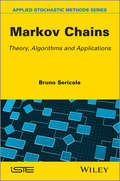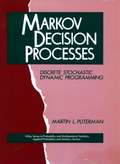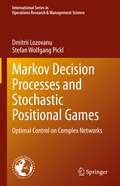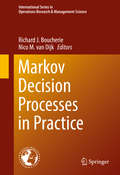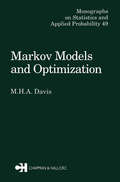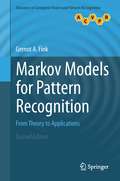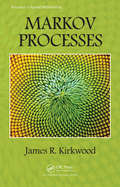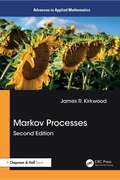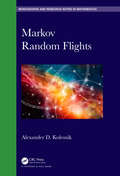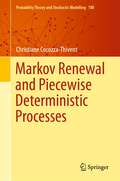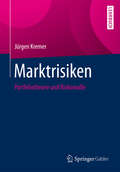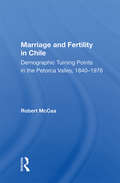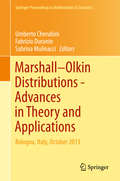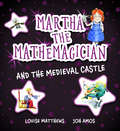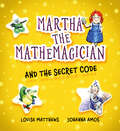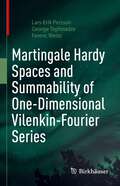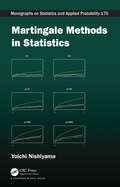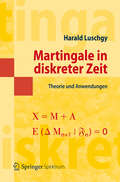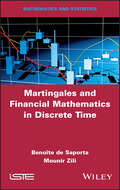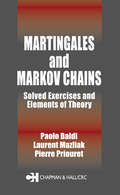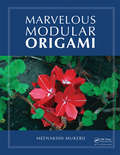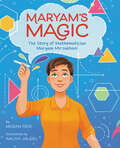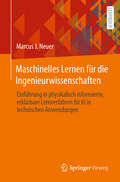- Table View
- List View
Markov Chains: Theory and Applications
by Bruno SericolaMarkov chains are a fundamental class of stochastic processes. They are widely used to solve problems in a large number of domains such as operational research, computer science, communication networks and manufacturing systems. The success of Markov chains is mainly due to their simplicity of use, the large number of available theoretical results and the quality of algorithms developed for the numerical evaluation of many metrics of interest. The author presents the theory of both discrete-time and continuous-time homogeneous Markov chains. He carefully examines the explosion phenomenon, the Kolmogorov equations, the convergence to equilibrium and the passage time distributions to a state and to a subset of states. These results are applied to birth-and-death processes. He then proposes a detailed study of the uniformization technique by means of Banach algebra. This technique is used for the transient analysis of several queuing systems. Contents 1. Discrete-Time Markov Chains 2. Continuous-Time Markov Chains 3. Birth-and-Death Processes 4. Uniformization 5. Queues About the Authors Bruno Sericola is a Senior Research Scientist at Inria Rennes – Bretagne Atlantique in France. His main research activity is in performance evaluation of computer and communication systems, dependability analysis of fault-tolerant systems and stochastic models.
Markov Decision Processes
by Martin L. PutermanThe Wiley-Interscience Paperback Series consists of selected books that have been made more accessible to consumers in an effort to increase global appeal and general circulation. With these new unabridged softcover volumes, Wiley hopes to extend the lives of these works by making them available to future generations of statisticians, mathematicians, and scientists."This text is unique in bringing together so many results hitherto found only in part in other texts and papers. . . . The text is fairly self-contained, inclusive of some basic mathematical results needed, and provides a rich diet of examples, applications, and exercises. The bibliographical material at the end of each chapter is excellent, not only from a historical perspective, but because it is valuable for researchers in acquiring a good perspective of the MDP research potential."-Zentralblatt fur Mathematik". . . it is of great value to advanced-level students, researchers, and professional practitioners of this field to have now a complete volume (with more than 600 pages) devoted to this topic. . . . Markov Decision Processes: Discrete Stochastic Dynamic Programming represents an up-to-date, unified, and rigorous treatment of theoretical and computational aspects of discrete-time Markov decision processes."-Journal of the American Statistical Association
Markov Decision Processes and Stochastic Positional Games: Optimal Control on Complex Networks (International Series in Operations Research & Management Science #349)
by Dmitrii Lozovanu Stefan Wolfgang PicklThis book presents recent findings and results concerning the solutions of especially finite state-space Markov decision problems and determining Nash equilibria for related stochastic games with average and total expected discounted reward payoffs. In addition, it focuses on a new class of stochastic games: stochastic positional games that extend and generalize the classic deterministic positional games. It presents new algorithmic results on the suitable implementation of quasi-monotonic programming techniques. Moreover, the book presents applications of positional games within a class of multi-objective discrete control problems and hierarchical control problems on networks. Given its scope, the book will benefit all researchers and graduate students who are interested in Markov theory, control theory, optimization and games.
Markov Decision Processes in Practice
by Richard J. Boucherie Nico M. van DijkThis book utilizes classical Markov Decision Processes (MDP) for real-life applications and optimization. MDP allows users to develop and formally support approximate and simple decision rules, and this book showcases state-of-the-art applications in which MDP was key to the solution approach. The book is divided into six parts. Part 1 is devoted to the state-of-the-art theoretical foundation of MDP, including approximate methods such as policy improvement, successive approximation and infinite state spaces as well as an instructive chapter on Approximate Dynamic Programming. It then continues with five parts of specific and non-exhaustive application areas. Part 2 covers MDP healthcare applications, which includes different screening procedures, appointment scheduling, ambulance scheduling and blood management. Part 3 explores MDP modeling within transportation. This ranges from public to private transportation, from airports and traffic lights to car parking or charging your electric car . Part 4 contains three chapters that illustrates the structure of approximate policies for production or manufacturing structures. In Part 5, communications is highlighted as an important application area for MDP. It includes Gittins indices, down-to-earth call centers and wireless sensor networks. Finally Part 6 is dedicated to financial modeling, offering an instructive review to account for financial portfolios and derivatives under proportional transactional costs. The MDP applications in this book illustrate a variety of both standard and non-standard aspects of MDP modeling and its practical use. This book should appeal to readers for practitioning, academic research and educational purposes, with a background in, among others, operations research, mathematics, computer science, and industrial engineering.
Markov Models & Optimization (Chapman And Hall/crc Monographs On Statistics And Applied Probability Ser. #49)
by M.H.A. DavisThis book presents a radically new approach to problems of evaluating and optimizing the performance of continuous-time stochastic systems. This approach is based on the use of a family of Markov processes called Piecewise-Deterministic Processes (PDPs) as a general class of stochastic system models. A PDP is a Markov process that follows deterministic trajectories between random jumps, the latter occurring either spontaneously, in a Poisson-like fashion, or when the process hits the boundary of its state space. This formulation includes an enormous variety of applied problems in engineering, operations research, management science and economics as special cases; examples include queueing systems, stochastic scheduling, inventory control, resource allocation problems, optimal planning of production or exploitation of renewable or non-renewable resources, insurance analysis, fault detection in process systems, and tracking of maneuvering targets, among many others.The first part of the book shows how these applications lead to the PDP as a system model, and the main properties of PDPs are derived. There is particular emphasis on the so-called extended generator of the process, which gives a general method for calculating expectations and distributions of system performance functions. The second half of the book is devoted to control theory for PDPs, with a view to controlling PDP models for optimal performance: characterizations are obtained of optimal strategies both for continuously-acting controllers and for control by intervention (impulse control). Throughout the book, modern methods of stochastic analysis are used, but all the necessary theory is developed from scratch and presented in a self-contained way. The book will be useful to engineers and scientists in the application areas as well as to mathematicians interested in applications of stochastic analysis.
Markov Models for Pattern Recognition
by Gernot A. FinkThis thoroughly revised and expanded new edition now includes a more detailed treatment of the EM algorithm, a description of an efficient approximate Viterbi-training procedure, a theoretical derivation of the perplexity measure and coverage of multi-pass decoding based on n-best search. Supporting the discussion of the theoretical foundations of Markov modeling, special emphasis is also placed on practical algorithmic solutions. Features: introduces the formal framework for Markov models; covers the robust handling of probability quantities; presents methods for the configuration of hidden Markov models for specific application areas; describes important methods for efficient processing of Markov models, and the adaptation of the models to different tasks; examines algorithms for searching within the complex solution spaces that result from the joint application of Markov chain and hidden Markov models; reviews key applications of Markov models.
Markov Processes (Advances in Applied Mathematics)
by James R. KirkwoodClear, rigorous, and intuitive, Markov Processes provides a bridge from an undergraduate probability course to a course in stochastic processes and also as a reference for those that want to see detailed proofs of the theorems of Markov processes. It contains copious computational examples that motivate and illustrate the theorems. The text is desi
Markov Processes (Advances in Applied Mathematics)
by James R. KirkwoodMarkov Processes provides a bridge from an undergraduate probability course to a course in stochastic processes. The text is designed to be understandable to students who have taken an undergraduate probability course without needing an instructor to fill in any gaps.Clear, rigorous, and intuitive, the second edition builds on the successful first, used in courses and as a reference for those who want to see detailed proofs of the theorems of Markov processes. It contains copious computational examples that motivate and illustrate the theorems.This second edition presents a new chapter illustrating the utility of using digraphs to describe whether a Markov process is reducible, absorbing, etc. There are additional exercises, and some material has been applied in a number of fields, including economics, physics, and mathematical biology.This book begins with a review of basic probability, then covers the case of finite-state, discrete-time Markov processes. Building on this, the text deals with the discrete-time, infinite-state case and provides background for continuous Markov processes with exponential random variables and Poisson processes. It presents continuous Markov processes that include the basic content of Kolmogorov’s equations, infinitesimal generators, and explosions. This book concludes with coverage of both discrete and continuous reversible Markov chains.While Markov processes are touched on in probability courses, this book offers the opportunity to concentrate on the topic when additional study is required. It creates a more seamless transition to prepare the student for what comes next.
Markov Random Flights (Chapman & Hall/CRC Monographs and Research Notes in Mathematics)
by Alexander D. KolesnikMarkov Random Flights is the first systematic presentation of the theory of Markov random flights in the Euclidean spaces of different dimensions. Markov random flights is a stochastic dynamic system subject to the control of an external Poisson process and represented by the stochastic motion of a particle that moves at constant finite speed and changes its direction at random Poisson time instants. The initial (and each new) direction is taken at random according to some probability distribution on the unit sphere. Such stochastic motion is the basic model for describing many real finite-velocity transport phenomena arising in statistical physics, chemistry, biology, environmental science and financial markets. Markov random flights acts as an effective tool for modelling the slow and super-slow diffusion processes arising in various fields of science and technology. Features: Provides the first systematic presentation of the theory of Markov random flights in the Euclidean spaces of different dimensions. Suitable for graduate students and specialists and professionals in applied areas. Introduces a new unified approach based on the powerful methods of mathematical analysis, such as integral transforms, generalized, hypergeometric and special functions. Author Alexander D. Kolesnik is a professor, Head of Laboratory (2015–2019) and principal researcher (since 2020) at the Institute of Mathematics and Computer Science, Kishinev (Chișinău), Moldova. He graduated from Moldova State University in 1980 and earned his PhD from the Institute of Mathematics of the National Academy of Sciences of Ukraine, Kiev in 1991. He also earned a PhD Habilitation in mathematics and physics with specialization in stochastic processes, probability and statistics conferred by the Specialized Council at the Institute of Mathematics of the National Academy of Sciences of Ukraine and confirmed by the Supreme Attestation Commission of Ukraine in 2010. His research interests include: probability and statistics, stochastic processes, random evolutions, stochastic dynamic systems, random flights, diffusion processes, transport processes, random walks, stochastic processes in random environments, partial differential equations in stochastic models, statistical physics and wave processes. Dr. Kolesnik has published more than 70 scientific publications, mostly in high-standard international journals and a monograph. He has also acted as external referee for many outstanding international journals in mathematics and physics, being awarded by the "Certificate of Outstanding Contribution in Reviewing" from the journal "Stochastic Processes and their Applications." He was the visiting professor and scholarship holder at universities in Italy and Germany and member of the Board of Global Advisors of the International Federation of Nonlinear Analysts (IFNA), United States of America.
Markov Renewal and Piecewise Deterministic Processes (Probability Theory and Stochastic Modelling #100)
by Christiane Cocozza-ThiventThis book is aimed at researchers, graduate students and engineers who would like to be initiated to Piecewise Deterministic Markov Processes (PDMPs). A PDMP models a deterministic mechanism modified by jumps that occur at random times. The fields of applications are numerous : insurance and risk, biology, communication networks, dependability, supply management, etc. Indeed, the PDMPs studied so far are in fact deterministic functions of CSMPs (Completed Semi-Markov Processes), i.e. semi-Markov processes completed to become Markov processes. This remark leads to considerably broaden the definition of PDMPs and allows their properties to be deduced from those of CSMPs, which are easier to grasp. Stability is studied within a very general framework. In the other chapters, the results become more accurate as the assumptions become more precise. Generalized Chapman-Kolmogorov equations lead to numerical schemes. The last chapter is an opening on processes for which the deterministic flow of the PDMP is replaced with a Markov process. Marked point processes play a key role throughout this book.
Marktrisiken
by Jürgen KremerIn diesem Buch werden Konzepte zur Quantifizierung von Marktrisiken dargestellt. Im Rahmen der im ersten Kapitel vorgestellten Portfoliotheorie werden Kapitalanlagen charakterisiert, die nach Vorgabe eines Risikos eine möglichst hohe erwartete Rendite versprechen. Risiko wird hier definiert als die Standardabweichung der Portfoliorendite.Für arbitragefreie Ein-Perioden-Modelle lassen sich optimale Portfolios auch mithilfe von Wahrscheinlichkeitsdichten explizit angeben, und die Martingalmaße vollständiger arbitragefreier Marktmodelle lassen sich umgekehrt mithilfe des Marktportfolios und der Kovarianzmatrix der klassischen Portfoliotheorie darstellen, was im zweiten Kapitel ausgeführt wird.Im dritten Kapitel wird das wichtige Risikomaß Value at Risk vorgestellt, das den größten Verlust eines Portfolios quantifiziert, der mit einer vorgegebenen Wahrscheinlichkeit in einem vorgegebenen Zeitraum nicht überschritten wird. Neben der Delta-Normal-Methode zur näherungsweisen Berechnung des Value at Risk werden auch auf dieser Methode basierende Zerlegungen des Gesamtrisikos in Teilrisiken und Sensitivitäten des Value at Risk gegenüber Änderungen der Risikofaktoren behandelt.Der Value at Risk macht keine Aussagen über die Verteilung der hohen Verluste und er ist nicht subadditiv. Die Formulierung von Eigenschaften, die ein gutes Risikomaß haben sollte, führt zum Konzept der kohärenten Risikomaße, die im vierten Kapitel zusammen mit ihrem wichtigsten Vertreter, dem Expected Shortfall, vorgestellt werden. Der Expected Shortfall wird als kohärent nachgewiesen, und seine Berechnung wird für normalverteilte und lognormalverteilte Auszahlungen explizit angegeben.Jedes Kapitel endet mit einer Reihe von Aufgaben, für die sich im letzten Kapitel vollständige Lösungen finden.
Marriage And Fertility In Chile: Demographic Turning Points In The Petorca Valley, 1840-1976
by Robert MccaaRecent population increases in Latin America have forced population experts to search for historical precedents and to examine the latest demographic data in an attempt to forecast the likely course of future trends. This book is the first demographic study of a Latin American community based on the family genealogy method developed by French histo
Marriage and Fertility Behaviour in Japan: Economic Status and Value-Orientation
by Nobutaka FukudaThis monograph examines the influence of ideational and socio-economic factors on Japanese marriage and fertility behaviour. It also investigates the historical change in attitudes toward partnership and family in Japan, which, if current trends continue, can lead to population shrinkage and an asymmetrical age structure.The author first details the differences between ideational and economic approaches. He examines these two behavioural models from a viewpoint of rational choice theory, which he then follows with a discussion on the influence of institutional contexts on matrimony and childbirth. Next, the book considers salient features of Japanese marriage behaviour, including the relation between these patterns and changes in society and the influence of marriage on attitudes toward partnership and family relations. Coverage then goes on to explore the influence of ideational factors on fertility and analyse the impact of childbirth on couples' attitudes. The author also investigates attitudinal changes between generations in Japan. He provides a theoretical review on the relation between socio-economic development and value-orientation as well as looks at the difference in attitudes from a viewpoint of cohorts and periods. Overall, the book presents an authoritative, theoretical and empirical analysis using data from panel and repeated cross-sectional surveys. Throughout, the author clearly identifies the sources of his data as well as the methods used in his analysis.
Marshall Olkin Distributions - Advances in Theory and Applications
by Umberto Cherubini Sabrina Mulinacci Fabrizio DuranteThis book presents the latest advances in the theory and practice of Marshall-Olkin distributions. These distributions have been increasingly applied in statistical practice in recent years, as they make it possible to describe interesting features of stochastic models like non-exchangeability, tail dependencies and the presence of a singular component. The book presents cutting-edge contributions in this research area, with a particular emphasis on financial and economic applications. It is recommended for researchers working in applied probability and statistics, as well as for practitioners interested in the use of stochastic models in economics. This volume collects selected contributions from the conference "Marshall-Olkin Distributions: Advances in Theory and Applications," held in Bologna on October 2-3, 2013.
Martha the Mathemagician and the Medieval Castle (Martha the Mathemagician)
by Joh Amos Louise MatthewsMartha the Mathemagician lives on Calculation Island (where numbers grow on trees) with her life-long best friend Oscar the Owl and her grandfather Max, who is an old and wise mathemagician. In this second book of the series, Martha uses her magic calculator for the first time. She and Oscar are transported to a dramatic argument between Knights about who will save the Princess from the dragon. Again she meets the Halving Ladybird to solve the problem she faces. Oh, and empowers the Princess while she's at it... Beautifully and amusingly illustrated, the story is designed to be read with children by parent or teacher. But it will also serve young readers well as they explore the world— especially as there are so few stories that have mathematics at their heart. Martha the Mathemagician will charm children and adults alike and make the world of numbers a comfortable and exciting place to be.
Martha the Mathemagician and the Secret Code (Martha the Mathemagician)
by Joh Amos Louise MatthewsMartha the Mathemagician lives on Calculation Island (where numbers grow on trees) with her life-long best friend Oscar the Owl and her grandfather Max, who is an old and wise mathemagician. In this first book of the series, Martha is given her magic calculator and has to discover the secret code that will unlock its powers. She and Oscar meet the Halving Ladybird, the Number Eating Crocodile, the Doubling Butterfly, and the Making Five Starfish in their search for the answer. Beautifully and amusingly illustrated, the story is designed to be read with children by parent or teacher. But it will also serve young readers well as they explore the world— especially as there are so few stories that have mathematics at their heart. Martha the Mathemagician will charm children and adults alike and make the world of numbers a comfortable and exciting place to be.
Martingale Hardy Spaces and Summability of One-Dimensional Vilenkin-Fourier Series
by Ferenc Weisz Lars-Erik Persson George TephnadzeThis book discusses, develops and applies the theory of Vilenkin-Fourier series connected to modern harmonic analysis.The classical theory of Fourier series deals with decomposition of a function into sinusoidal waves. Unlike these continuous waves the Vilenkin (Walsh) functions are rectangular waves. Such waves have already been used frequently in the theory of signal transmission, multiplexing, filtering, image enhancement, code theory, digital signal processing and pattern recognition. The development of the theory of Vilenkin-Fourier series has been strongly influenced by the classical theory of trigonometric series. Because of this it is inevitable to compare results of Vilenkin-Fourier series to those on trigonometric series. There are many similarities between these theories, but there exist differences also. Much of these can be explained by modern abstract harmonic analysis, which studies orthonormal systems from the point of view of the structure of a topological group.The first part of the book can be used as an introduction to the subject, and the following chapters summarize the most recent research in this fascinating area and can be read independently. Each chapter concludes with historical remarks and open questions. The book will appeal to researchers working in Fourier and more broad harmonic analysis and will inspire them for their own and their students' research. Moreover, researchers in applied fields will appreciate it as a sourcebook far beyond the traditional mathematical domains.
Martingale Methods in Statistics (Chapman & Hall/CRC Monographs on Statistics and Applied Probability #1)
by Yoichi NishiyamaMartingale Methods in Statistics provides a unique introduction to statistics of stochastic processes written with the author’s strong desire to present what is not available in other textbooks. While the author chooses to omit the well-known proofs of some of fundamental theorems in martingale theory by making clear citations instead, the author does his best to describe some intuitive interpretations or concrete usages of such theorems. On the other hand, the exposition of relatively new theorems in asymptotic statistics is presented in a completely self-contained way. Some simple, easy-to-understand proofs of martingale central limit theorems are included. The potential readers include those who hope to build up mathematical bases to deal with high-frequency data in mathematical finance and those who hope to learn the theoretical background for Cox’s regression model in survival analysis. A highlight of the monograph is Chapters 8-10 dealing with Z-estimators and related topics, such as the asymptotic representation of Z-estimators, the theory of asymptotically optimal inference based on the LAN concept and the unified approach to the change point problems via "Z-process method". Some new inequalities for maxima of finitely many martingales are presented in the Appendix. Readers will find many tips for solving concrete problems in modern statistics of stochastic processes as well as in more fundamental models such as i.i.d. and Markov chain models.
Martingale in diskreter Zeit
by Harald LuschgyMartingale haben die Wahrscheinlichkeitstheorie derart revolutioniert, dass die Suche nach "guten" Martingalen inzwischen eine Standardmethode zur Untersuchung stochastischer Probleme ist. Das Buch führt in die Theorie der reellen Martingale in diskreter Zeit ein und zeigt in Teil 2 einige ihrer Anwendungen; dazu zählen u. a. das finanzmathematische Problem der Optionsbewertung, der Galton-Watson-Verzweigungsprozess, U-Statistiken und die unbedingte Basiseigenschaft von Martingal-Basen in Lp-Räumen. Mit zahlreichen Übungsaufgaben zu jedem Kapitel.
Martingales and Financial Mathematics in Discrete Time
by Benoîte de Saporta Mounir ZiliThis book is entirely devoted to discrete time and provides a detailed introduction to the construction of the rigorous mathematical tools required for the evaluation of options in financial markets. Both theoretical and practical aspects are explored through multiple examples and exercises, for which complete solutions are provided. Particular attention is paid to the Cox, Ross and Rubinstein model in discrete time.The book offers a combination of mathematical teaching and numerous exercises for wide appeal. It is a useful reference for students at the master’s or doctoral level who are specializing in applied mathematics or finance as well as teachers, researchers in the field of economics or actuarial science, or professionals working in the various financial sectors.Martingales and Financial Mathematics in Discrete Time is also for anyone who may be interested in a rigorous and accessible mathematical construction of the tools and concepts used in financial mathematics, or in the application of the martingale theory in finance
Martingales and Markov Chains: Solved Exercises and Elements of Theory
by Paolo Baldi Laurent Mazliak Pierre PriouretA thorough grounding in Markov chains and martingales is essential in dealing with many problems in applied probability, and is a gateway to the more complex situations encountered in the study of stochastic processes. Exercises are a fundamental and valuable training tool that deepen students' understanding of theoretical principles and prepare th
Martingales in Banach Spaces
by Gilles PisierThis book focuses on the major applications of martingales to the geometry of Banach spaces, and a substantial discussion of harmonic analysis in Banach space valued Hardy spaces is also presented. It covers exciting links between super-reflexivity and some metric spaces related to computer science, as well as an outline of the recently developed theory of non-commutative martingales, which has natural connections with quantum physics and quantum information theory. Requiring few prerequisites and providing fully detailed proofs for the main results, this self-contained study is accessible to graduate students with a basic knowledge of real and complex analysis and functional analysis. Chapters can be read independently, with each building from the introductory notes, and the diversity of topics included also means this book can serve as the basis for a variety of graduate courses.
Marvelous Modular Origami (Ak Peters Ser.)
by Meenakshi MukerjiThis richly illustrated book provides step-by-step instructions for the construction of over 30 different modular origami structures. The author describes basic folding techniques required to construct the “modules” that are used as building blocks to construct complex ornamental models. The diagrams are clear, crisp, and easy to follow, and are accompanied by inspiring color photographs. Additional tips encourage the reader to design their own original creations. Advance Praise for Marvelous Modular Origami "A must-have for any modular origami polyhedra enthusiast." -Rona Gurkewitz, co-author of Multimodular Origami Polyhedra "The models are paper folding in its purest form. They range from simple Sonobe to floral and geometrical constructions. All are eye-catching and satisfying to fold, and the finished constructions are pleasing to behold. Also included are short sections on the mathematics behind the shapes and optimum color choices." -David Petty, author of Origami A-B-C "In this colorful book, you'll find wonderful original origami modular creations. Meenakshi's clear instructions and helpful hints will have you zipping through these modules as well as improvising your own." -Rachel Katz, co-author of FUN FOLDS: Language Learning Through Paper Folding "Marvelous Modular Origami is a colorful addition to the literature of mathematical origami." -Florence Temko, author of many origami and other craft books
Maryam's Magic: The Story of Mathematician Maryam Mirzakhani
by Megan ReidFrom Althea Gibson author Megan Reid and rising star artist Aaliya Jaleel, illustrator of Under My Hijab, comes the first picture book about trailblazing mathematician Maryam Mirzakhani, the first woman to win the world’s most prestigious honor in mathematics. Perfect for fans of Hidden Figures and Mae Among the Stars. As a little girl, Maryam Mirzakhani was spellbound by stories. She loved reading in Tehran’s crowded bookstores, and at home she'd spend hours crafting her own tales on giant rolls of paper. Maryam loved school, especially her classes in reading and writing. But she did not like math. Numbers were nowhere near as interesting as the bold, adventurous characters she found in books. Until Maryam unexpectedly discovered a new genre of storytelling: In geometry, numbers became shapes, each with its own fascinating personality—making every equation a brilliant story waiting to be told. As an adult, Maryam became a professor, inventing new formulas to solve some of math's most complicated puzzles. And she made history by becoming the first woman—and the first Iranian—to win the Fields Medal, mathematics’ highest award. Maryam's Magic is the true story of a girl whose creativity and love of stories helped her—and the world—to see math in a new and inspiring way.
Maschinelles Lernen für die Ingenieurwissenschaften: Einführung in physikalisch informierte, erklärbare Lernverfahren für KI in technischen Anwendungen
by Marcus J NeuerMaschinelles Lernen und künstliche Intelligenz sind omnipräsente Begriffe zur Verbesserung von technischen Prozessen. Die praktische Umsetzung an realen Problemen gestaltet sich aber oft schwierig und komplex. Dieses Lehrbuch erklärt Lernverfahren anhand von analytischen Konzepten im Zusammenspiel mit vollständigen Programmierbeispielen in Python und bezieht sich auf dabei stets auf reale technische Anwendungsszenarien. Es zeigt den Einsatz physikalisch-informierter Lernstrategien, die Einbeziehung von Unsicherheit in die Modellierung und den Aufbau von erklärbarer, vertrauenswürdiger künstlicher Intelligenz mit Hilfe spezialisierter Datenbanken.Dieses Lehrbuch richtet sich somit sowohl an Studierende der Ingenieurswissenschaften, Naturwissenschaft, Medizin und Betriebswirtschaft als auch an Anwender aus der Industrie (vor allem Data Scientists), Entwickler*innen von Expertendatenbanken und Softwareentwickler*innen.
